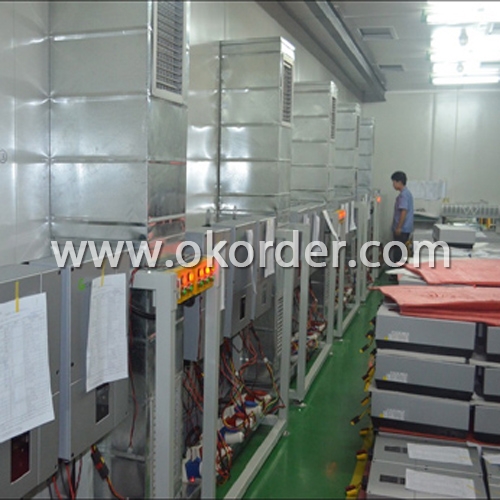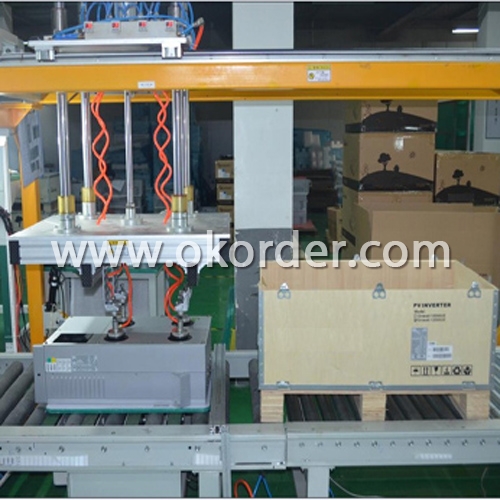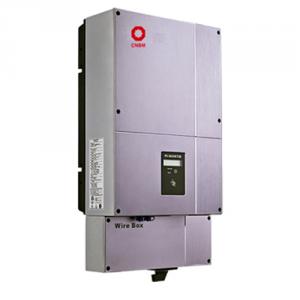Grid Tied Solar Inverter 3-phase
- Loading Port:
- Shenzhen
- Payment Terms:
- TT or LC
- Min Order Qty:
- 1 unit pc
- Supply Capability:
- 5000 Units/per month pc/month
OKorder Service Pledge
OKorder Financial Service
You Might Also Like
Grid Tied Solar Inverter 3-phase 20000W
CNBM International Corporation (CNBM International) is the most important trading platform of CNBM Group Corporation, a state-owned company under the direct supervision of State-owned Assets Supervision and Administration Commission of the State Council.
With a R&D team more than 100 engineers,40% of the staff, who has been deeply engaged in the photovoltaic industry for 10 years, CNBM takes the mission to increase the inverter availability and efficiency, putting continuous innovation to make CNBM inverter easier for installation and operation, and more cost-effective for solar plant construction. The full range of CNBM single phase inverters has received VDE, CE, G83/1, G59/2, ENEL2010, VDE4105, C10/C11, AS4777 etc.
Maximum efficiency of 97.8% and wide input voltage range, Internal DCswitch,MTL-String, Sound control,Bluetooth/RF technology /Wi-FiTransformerless,GT topology
The Grid Connected Solar Inverter we can offer is 1.5kw to 20kw.
Introduction of Grid Tied Solar Inverter 3-phase 20000W
Maximum efficiency of 97.8% and wide input voltage range
Integrated DC switch-disconnected
MTL-String
Sound control
Bluetooth/RF technology /Wi-Fi
Transformerless GT topology
5 years warranty (10 years as optional)
Datasheet of Grid Tied Solar Inverter 3-phase 20000W
Model | 10000TL3-US | 12000TL3-US | 18000TL3-US | 20000TL3-US |
Input data(DC) | ||||
Max. DC Power | 10500W | 12500W | 18750W | 20850W |
Max. DC voltage | 600V | 600V | 600V | 600V |
Start voltage | 120V | 120V | 120V | 120V |
PV voltage range | 80V-600V | 80V-600V | 80V-600V | 80V-600V |
Max. input current of the MPP tracker A/tracker B | 21A/21A | 25A/25A | 38A/38A | 42A/42A |
Number of MPP trackers/strings per MPP tracker | 2/3 | 2/3 | 2/6 | 2/6 |
Output data(AC) | ||||
Nominal output power | 10000W | 12000W | 18000W | 20000W |
Nominal AC voltage | 480V | 480V | 480V | 480V |
AC voltage range | 422-528VAC | 422-528VAC | 422-528VAC | 422-528VAC |
Nominal AC grid frequency | 60 Hz | 60 Hz | 60 Hz | 60 Hz |
Max. output current(cos φ=1) | 12.0A | 14.5A | 21.5A | 24A |
Power factor(cos φ) | >0.99 | >0.99 | >0.99 | >0.99 |
Harmonics | <3% | <3% | <3% | <3% |
Grid connection type | 3/N/E | 3/N/E | 3/N/E | 3/N/E |
Efficiency | ||||
Max. efficiency | 97% | 97% | 97.5% | 97.5% |
CEC-Weighted efficiency | 95.5% | 95.5% | 96% | 96.5% |
MPPT efficiency | 99.5% | 99.5% | 99.5% | 99.5% |
Protection devices | ||||
Input over voltage protection -DIN rail surge arrester(Option) | Class II | Class II | Class II | Class II |
DC insulation measure | yes | yes | yes | yes |
AC short circuit protection | yes | yes | yes | yes |
Output over voltage protection -Varistor | yes | yes | yes | yes |
Output over voltage protection -DIN rail surge arrester(Option) | Class II | Class II | Class II | Class II |
String fuse type/size(Option) | 15A/600VDC 10*38mm | 15A/600VDC 10*38mm | 15A/600VDC 10*38mm | 15A/600VDC 10*38mm |
General Data | ||||
Dimensions(W*H*D) in mm | 530*705*247 | 530*705*247 | 650*740*247 | 650*740*247 |
Weight | 46kg/101.5lb | 46kg/101.5lb | 63kg/138.9lb | 63kg/138.9lb |
Operating ambient temperature range | –25°C ... +60°C | –25°C ... +60°C | –25°C ... +60°C | –25°C ... +60°C |
Altitude | ≤2000m/6560ft | |||
Self Consumption night | < 3 W | < 3 W | < 3 W | < 3 W |
Topology | Transformerless | |||
Cooling concept | Fan Cool | Fan Cool | Fan Cool | Fan Cool |
Electronics protection rating /connection area | NEMA 3R | NEMA 3R | NEMA 3R | NEMA 3R |
Features | ||||
Display | Graphic | Graphic | Graphic | Graphic |
Interface:RS232/RS485/ Bluetooth/RF/Zigbee/Wifi | yes/yes/opt/opt /opt/opt | |||
Warranty:10 years /15 years | yes/opt | yes/opt | yes/opt | yes/opt |
Certificates and approvals | UL1741,UL1998,IEEE1547,FCC part 15(class B),CSA C22.2 No.107.1 | |||
Picture 1: Factory of Grid Tied Solar Inverter 3-phase 20000W

Picture 2: Package of Grid Tied Solar Inverter 3-phase 20000W

- Q:How does a solar inverter impact the overall system reliability?
- A solar inverter plays a crucial role in the overall system reliability as it converts the direct current (DC) generated by solar panels into alternating current (AC) that can be used to power household appliances or be fed into the grid. It ensures the reliable and efficient functioning of the entire solar power system by optimizing power output, managing voltage levels, and protecting against various electrical faults. A high-quality solar inverter enhances system performance, improves energy yield, and minimizes downtime, ultimately increasing the overall reliability of the solar power system.
- Q:What is the role of a communication interface in a solar inverter?
- The role of a communication interface in a solar inverter is to facilitate the exchange of information and data between the solar inverter and other devices or systems. It allows for monitoring and control of the inverter's performance, as well as integration with other renewable energy systems or smart grid technologies. The communication interface enables remote access, diagnostics, and troubleshooting, enabling efficient operation and maintenance of the solar inverter.
- Q:How does a solar inverter handle grid voltage variations?
- A solar inverter handles grid voltage variations by constantly monitoring the grid voltage and adjusting its output accordingly. It uses complex algorithms to regulate the voltage and frequency of the electricity it feeds into the grid, ensuring it matches the varying grid voltage. This allows the solar inverter to maintain a stable and consistent power output, regardless of any fluctuations in the grid voltage.
- Q:Can a solar inverter be used in a stand-alone solar system?
- Yes, a solar inverter can be used in a stand-alone solar system. In fact, it is an essential component as it converts the direct current (DC) generated by the solar panels into usable alternating current (AC) for powering appliances and electronics. This allows the stand-alone solar system to meet the energy needs of off-grid locations or areas with limited access to the main power grid.
- Q:Can a solar inverter be used with micro-inverters?
- Yes, a solar inverter can be used with micro-inverters. In fact, micro-inverters are designed to work in conjunction with a central solar inverter. The role of the micro-inverter is to convert the DC power generated by individual solar panels into AC power, which can then be fed into the central inverter for further conversion and distribution to the electrical grid. This combination allows for optimized power production and monitoring of individual panel performance.
- Q:Can a solar inverter be integrated with a smart home system?
- Yes, a solar inverter can be integrated with a smart home system. Many modern solar inverters have built-in communication capabilities, such as Wi-Fi or Ethernet, which allow them to connect to a smart home system. This integration enables homeowners to monitor and control their solar power production and energy consumption conveniently through a centralized smart home platform. They can track energy production, set energy usage preferences, and even automate certain functions based on available solar power.
- Q:What is the role of a solar inverter in a residential system?
- The role of a solar inverter in a residential system is to convert the direct current (DC) electricity produced by the solar panels into alternating current (AC) electricity that can be used to power household appliances and be fed into the electrical grid. It ensures efficient use of solar energy and enables easy integration of solar power into the existing electrical infrastructure of a home.
- Q:PV grid-connected inverter can directly load it?
- Grid-connected inverter is usually equipped with island protection function, can only receive the power grid, if the load directly, the output is disconnected.
- Q:Photovoltaic grid-connected inverter problem
- Hello, the definition of the zero line is not caused by the transformer three-phase electric tail connection? I now do not understand why there is no isolation transformer AC output marked is N (zero line), and it is not the transformer three-phase power of the tail connection leads to, this is the zero line? The The
- Q:Can a solar inverter be used in a floating solar system?
- Yes, a solar inverter can be used in a floating solar system. The inverter is an essential component of a solar power system that converts the direct current (DC) generated by the solar panels into alternating current (AC) electricity that can be used to power various devices or be fed into the grid. Whether the solar panels are installed on the ground, rooftops, or floating platforms, the inverter's role remains the same. Therefore, it can certainly be used in a floating solar system to ensure efficient and reliable power conversion.
1. Manufacturer Overview |
|
|---|---|
| Location | Shenzhen,China |
| Year Established | 2010 |
| Annual Output Value | 50 million USD |
| Main Markets | Australia, Euro, America, China. |
| Company Certifications | CE, VDE-AR-N4105, FCC,ETL,CEC,CEI 0-21,G83,G59,SAA,CGC |
2. Manufacturer Certificates |
|
|---|---|
| a) Certification Name | |
| Range | |
| Reference | |
| Validity Period | |
3. Manufacturer Capability |
|
|---|---|
| a)Trade Capacity | |
| Nearest Port | Shenzhen, Guangzhou, Hongkong |
| Export Percentage | 60% |
| No.of Employees in Trade Department | 260 |
| Language Spoken: | English, Chinese |
| b)Factory Information | |
| Factory Size: | 500-1000 |
| No. of Production Lines | 8 |
| Contract Manufacturing | None |
| Product Price Range | 300-40000 USD |
Send your message to us
Grid Tied Solar Inverter 3-phase
- Loading Port:
- Shenzhen
- Payment Terms:
- TT or LC
- Min Order Qty:
- 1 unit pc
- Supply Capability:
- 5000 Units/per month pc/month
OKorder Service Pledge
OKorder Financial Service
Similar products
New products
Hot products
Hot Searches
Related keywords





























